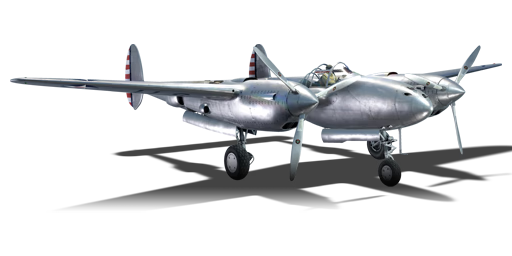


The YP-38 was developed after the loss of the only XP-38. It was intended to be a pre-production aircraft fitted with armament; two 7.62 mm machine guns, two 12.7 mm machine guns, and one 37 mm cannon. All were to be mounted in the nose however some YP-38s never received their weaponry. The YP-38 managed to shave off over 14,000 lbs (6,350 kg) from the original XP-38. In addition, the YP-38 also had its propellor direction reversed (outward rather than inwards) which greatly improved stability when firing the guns. In late 1940, the first YP-38s were completed and were later sent to the U.S. Army. Although it was redesigned and significantly lost weight, the YP-38 had major issues with high-speed dives. During a test flight, a YP-38 broke up during a high-speed dive and subsequently killed the pilot. It would take Lockheed two years to find out the true source of the issue during wind tunnel testing.
The YP-38 was introduced in Update "Raining Fire" and replaced the XP-38G. The YP-38 was later removed from the store in the 2023 Summer sale. Although with a troubled history, the YP-38 is a decent aircraft in-game. Firstly, all of the guns are mounted in the nose which greatly helps with accuracy. However, the guns are quite limited on ammo, so using them sparingly is important. The YP-38 can also climb well and is decently controllable at around 500 km/h (312 mph). Unfortunately, just like in real life, the YP-38 in-game suffers from high-speed manoeuvrability and can easily overspeed. The YP-38 is also limited in ground striking as it lacks any bombs/rockets and sufficient ammo for its guns.
flaps
flaps
flaps
brake
| Belt | Belt filling | Armor penetration (mm) at a distance: | |||||
|---|---|---|---|---|---|---|---|
| 10 m | 100 m | 500 m | 1000 m | 1500 m | 2000 m | ||
| HEFI-T/AP-T | 37 | 34 | 25 | 18 | 12 | 9 | |
| HEFI-T/HEFI-T/AP-T | 37 | 34 | 25 | 18 | 12 | 9 | |
| AP-T | 37 | 34 | 25 | 18 | 12 | 9 | |
| HEFI-T | 4 | 4 | 3 | 3 | 3 | 3 | |
| Belt | Belt filling | Armor penetration (mm) at a distance: | |||||
|---|---|---|---|---|---|---|---|
| 10 m | 100 m | 500 m | 1000 m | 1500 m | 2000 m | ||
| T/Ball/I/AP | 30 | 27 | 20 | 13 | 9 | 6 | |
| AP/AP/AP/T/I | 30 | 27 | 20 | 13 | 9 | 6 | |
| T/AP/AP/AP | 30 | 27 | 20 | 13 | 9 | 6 | |
| T/T/T/AP | 30 | 27 | 20 | 13 | 9 | 6 | |
| AP/I/AP | 30 | 27 | 20 | 13 | 9 | 6 | |
| Belt | Belt filling | Armor penetration (mm) at a distance: | |||||
|---|---|---|---|---|---|---|---|
| 10 m | 100 m | 500 m | 1000 m | 1500 m | 2000 m | ||
| T/Ball/Ball/Ball/AP/I | 13 | 12 | 7 | 3 | 2 | 0 | |
| T/AP/I | 13 | 12 | 7 | 3 | 2 | 0 | |
| AP/T/T/T/T | 13 | 12 | 7 | 3 | 2 | 0 | |
| AP/AP/AP/I/I | 13 | 12 | 7 | 3 | 2 | 0 | |







 2 x (70 / 235 / 240) %
2 x (70 / 235 / 240) % 
 2 x 130 %
2 x 130 % 

Flight performance | |
|---|---|
Survivability |
|---|
Weaponry | |
|---|---|